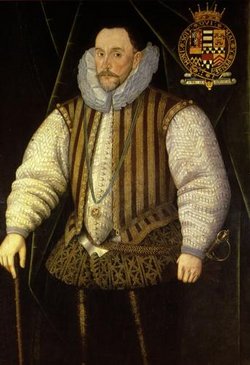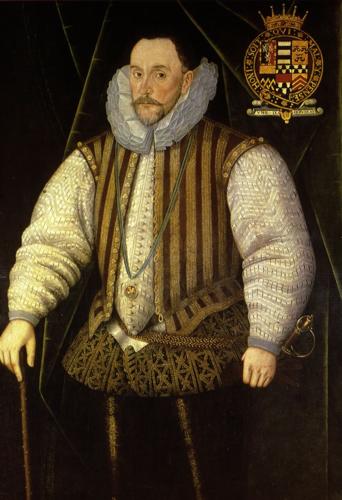Herbert was educated at Peterhouse, Cambridge, under Archbishop John Whitgift. He is also said to have studied at Douay.
In 1554, while his father was entertaining the entourage of Philip II of Spain's men at Wilton House, Herbert's discreet manners caught the attention of the Marquis de las Navas and he was made a gentleman of the chamber to King Philip upon his arrival in England. In 1557, he took part of a tournament held before Queen Mary, and accompanied his father to the siege of St. Quentin.
On his father's death in 1570, he succeeded to the Earldom of Pembroke and on 4 April 1570 was appointed Lord Lieutenant of Wiltshire. In right of his mother, Anne Parr, he succeeded as Lord Parr and Ros of Kendal, Lord FitzHugh, Lord Marmion, and Lord Quentin on 1 August 1571.
He was married to Lady Catherine Grey, sister of Lady Jane Grey, on 25 May 1553,[2] in a political match arranged by their parents in the hopes of assisting the Duke of Northumberland with his plan to secure the succession of Lady Jane who also married alongside her sister on that day, the Duke's younger son, Lord Guildford Dudley. The union was never consummated, and in 1554, Queen Mary's influence led to the consent of Herbert's father's dissolution of the marriage.
His second wife was Lady Catherine Talbot, daughter of George Talbot, 6th Earl of Shrewsbury, and his wife Lady Gertrude Manners, daughter of Thomas Manners, 1st Earl of Rutland. Queen Elizabeth was extremely fond of Lady Catherine and when Catherine developed a fatal illness she often visited her at Baynard's Castle. She died in 1575 leaving no children by Herbert.
By April 1577, Herbert married his third wife, the former Mary Sidney, daughter of Sir Henry Sidney and Lady Mary Dudley, daughter of John Dudley, 1st Duke of Northumberland. Their children included William and Philip, who both were Earl of Pembroke after their father, and Lady Anne Herbert who died young.
The armor of Henry Herbert is now on display at the Metropolitan Museum of Art in the Arms and Armor galleries. It was made in 1580 at the Greenwich armory, a royal workshop founded by Henry VIII to produce armor for the English nobility, chiefly Henry, without having to commission it from overseas. His portrait, and that of his father William, are on display at the National Museum Wales in Cardiff, adjacent to Cardiff Castle which the family owned and occupied for much of the sixteenth century.
From Wikipedia, the free encyclopedia
Herbert was educated at Peterhouse, Cambridge, under Archbishop John Whitgift. He is also said to have studied at Douay.
In 1554, while his father was entertaining the entourage of Philip II of Spain's men at Wilton House, Herbert's discreet manners caught the attention of the Marquis de las Navas and he was made a gentleman of the chamber to King Philip upon his arrival in England. In 1557, he took part of a tournament held before Queen Mary, and accompanied his father to the siege of St. Quentin.
On his father's death in 1570, he succeeded to the Earldom of Pembroke and on 4 April 1570 was appointed Lord Lieutenant of Wiltshire. In right of his mother, Anne Parr, he succeeded as Lord Parr and Ros of Kendal, Lord FitzHugh, Lord Marmion, and Lord Quentin on 1 August 1571.
He was married to Lady Catherine Grey, sister of Lady Jane Grey, on 25 May 1553,[2] in a political match arranged by their parents in the hopes of assisting the Duke of Northumberland with his plan to secure the succession of Lady Jane who also married alongside her sister on that day, the Duke's younger son, Lord Guildford Dudley. The union was never consummated, and in 1554, Queen Mary's influence led to the consent of Herbert's father's dissolution of the marriage.
His second wife was Lady Catherine Talbot, daughter of George Talbot, 6th Earl of Shrewsbury, and his wife Lady Gertrude Manners, daughter of Thomas Manners, 1st Earl of Rutland. Queen Elizabeth was extremely fond of Lady Catherine and when Catherine developed a fatal illness she often visited her at Baynard's Castle. She died in 1575 leaving no children by Herbert.
By April 1577, Herbert married his third wife, the former Mary Sidney, daughter of Sir Henry Sidney and Lady Mary Dudley, daughter of John Dudley, 1st Duke of Northumberland. Their children included William and Philip, who both were Earl of Pembroke after their father, and Lady Anne Herbert who died young.
The armor of Henry Herbert is now on display at the Metropolitan Museum of Art in the Arms and Armor galleries. It was made in 1580 at the Greenwich armory, a royal workshop founded by Henry VIII to produce armor for the English nobility, chiefly Henry, without having to commission it from overseas. His portrait, and that of his father William, are on display at the National Museum Wales in Cardiff, adjacent to Cardiff Castle which the family owned and occupied for much of the sixteenth century.
From Wikipedia, the free encyclopedia
Family Members
Advertisement
Explore more
Sponsored by Ancestry
Advertisement













